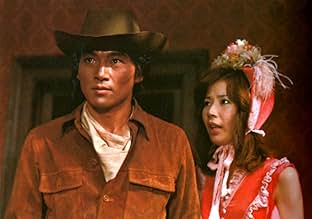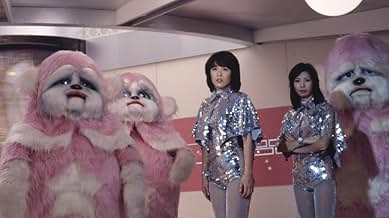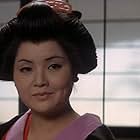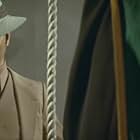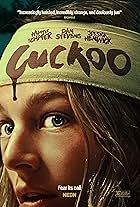- Director
- Writer
- All cast & crew
- Production, box office & more at IMDbPro
Storyline
Did you know
- ConnectionsFollowed by Pink Lady (1980)
Featured review
PINK LADY'S MOTION PICTURE (1978) was an awkward attempt to build a movie around Pink Lady, the name given a Japanese pop music duo consisting of the very pretty short-haired Mie and the long-haired Kei, stage names for Mitsuyo Nemoto and Keiko Masuda, respectively. Their popularity in Japan lasted from 1976 to 1979 before their attempt to break into the American market with the ill-fated TV show, "Pink Lady and Jeff" (1980), which wound up setting back the cause of J-pop in America by nearly 30 years. Mie and Kei were not the most accomplished singers or dancers, but they gained a certain amount of attention from the sexy disco-inspired outfits they wore in concert, generally featuring shiny scanty tops, tight hot pants and gold or silver boots, seen to good advantage in some segments of the movie. Their music has been revived over the years as younger performers, including Morning Musume and the MM-affiliated spin-off duo, W (Ai Kago and Nozomi Tsuji), have done covers of Pink Lady hits (and improved on them considerably, if you ask me). A 2008 Japanese TV movie, "Hitmaker: Aku Yu Monogatari," about songwriter Yu Aku, even cast two members of Morning Musume, Ai Takahashi and Risa Niigaki, as Mie and Kei in a sequence focusing on Pink Lady.
In any event, this 83-minute movie, seen only in a Japanese-language edition with no subtitles, offers up the premise of a meeting between a film producer, director and writer seeking to come up with a suitable movie genre to showcase Pink Lady. We are then treated to three imagined movies-within-the-movie. The choices seem designed to diminish whatever potential screen presence the girls might have had. If you could devise an even more ill-conceived framework for presenting pop stars to an audience, I'd rather not know. The movie seems intended as a show biz comedy, yet the first film idea enacted is a soap opera about two sisters, one of whom is an overworked nurse at a busy hospital, and their familial and romantic problems. It's very dramatic and drags on for nearly half-an-hour.
If you haven't bailed out by this point, the second story has a little more charm and features the girls as circus performers (in sharp yellow jackets, tights and boots) who show kindness toward a captured "monster," a sad, furry being (played by a man in a bulky, over-sized pink acrylic costume) who suffers acts of unusual cruelty by the keeper and ringmaster before the girls escape with the creature in a circus trailer. The girls make occasional roadside stops to try and teach the monster how to eat with a knife and a fork. This all leads to a chase over Japanese mountain highways and a trip by boat in the direction of Mount Fuji, from which a flying saucer flies up to rescue the creature, revealed to be from an alien race, and bring Mie and Kei along for the ride for some hijinks on board the ship before an eventful return to Tokyo.
The third story, filmed on a western set, is a standard Wild West tale with the girls as stage performers at a saloon who get mixed up with a handsome fugitive, an arrogant sheriff, and some leering bad guys. Everything's overplayed quite a bit, and sometimes the conferring creators back in the hotel room interrupt the story to make a change or stop the director, playing the sheriff, from kissing Mie in a scene he's crafted for himself. There is ample gunfire and outdoor chase action, but not much in the way of comedy. And when we first see the duo perform on stage, they're in unwieldy long dresses, with long sleeves and high collars, the last thing dance hall girls would wear. They look like they're about to get on a stagecoach, not a stage. Given the sexy costumes they wear in abundance everywhere else, this design choice is just plain weird.
In an odd touch, one of the stories ends on an alarming tragic note. There are other bizarre elements. In the circus/UFO story, there's a scene where several Tokyo schoolboys chase and physically attack some schoolgirls and try to pull their skirts and blouses off in broad daylight before Mie and Kei, now invisible thanks to alien technology, manage to intervene on the schoolgirls' behalf. In the western segment, the girls are manhandled quite roughly by some outlaws in one scene.
Fortunately, there are songs spread throughout the film. Sometimes the songs are part of the narrative, as when the girls sing "Monster" to the pink alien at the circus, or when they perform on stage at the saloon. Most of the time, we just see shots taken from a concert, clearly filmed for use in the movie. (In the soap opera segment, the girls keep turning on the TV, only to see Pink Lady in concert.) They don't often get to finish the songs, but all ten of their first ten singles, including "Southpaw," "UFO," and "Pepper Keibu," are featured on the soundtrack.
I honestly don't think English subtitles would have improved this one. All in all, I had a much better time with an earlier J-pop musical seen last month, also without subtitles, JANKEN MUSUME (1955), starring Japanese recording legend Hibari Misora and also reviewed on this site.
In any event, this 83-minute movie, seen only in a Japanese-language edition with no subtitles, offers up the premise of a meeting between a film producer, director and writer seeking to come up with a suitable movie genre to showcase Pink Lady. We are then treated to three imagined movies-within-the-movie. The choices seem designed to diminish whatever potential screen presence the girls might have had. If you could devise an even more ill-conceived framework for presenting pop stars to an audience, I'd rather not know. The movie seems intended as a show biz comedy, yet the first film idea enacted is a soap opera about two sisters, one of whom is an overworked nurse at a busy hospital, and their familial and romantic problems. It's very dramatic and drags on for nearly half-an-hour.
If you haven't bailed out by this point, the second story has a little more charm and features the girls as circus performers (in sharp yellow jackets, tights and boots) who show kindness toward a captured "monster," a sad, furry being (played by a man in a bulky, over-sized pink acrylic costume) who suffers acts of unusual cruelty by the keeper and ringmaster before the girls escape with the creature in a circus trailer. The girls make occasional roadside stops to try and teach the monster how to eat with a knife and a fork. This all leads to a chase over Japanese mountain highways and a trip by boat in the direction of Mount Fuji, from which a flying saucer flies up to rescue the creature, revealed to be from an alien race, and bring Mie and Kei along for the ride for some hijinks on board the ship before an eventful return to Tokyo.
The third story, filmed on a western set, is a standard Wild West tale with the girls as stage performers at a saloon who get mixed up with a handsome fugitive, an arrogant sheriff, and some leering bad guys. Everything's overplayed quite a bit, and sometimes the conferring creators back in the hotel room interrupt the story to make a change or stop the director, playing the sheriff, from kissing Mie in a scene he's crafted for himself. There is ample gunfire and outdoor chase action, but not much in the way of comedy. And when we first see the duo perform on stage, they're in unwieldy long dresses, with long sleeves and high collars, the last thing dance hall girls would wear. They look like they're about to get on a stagecoach, not a stage. Given the sexy costumes they wear in abundance everywhere else, this design choice is just plain weird.
In an odd touch, one of the stories ends on an alarming tragic note. There are other bizarre elements. In the circus/UFO story, there's a scene where several Tokyo schoolboys chase and physically attack some schoolgirls and try to pull their skirts and blouses off in broad daylight before Mie and Kei, now invisible thanks to alien technology, manage to intervene on the schoolgirls' behalf. In the western segment, the girls are manhandled quite roughly by some outlaws in one scene.
Fortunately, there are songs spread throughout the film. Sometimes the songs are part of the narrative, as when the girls sing "Monster" to the pink alien at the circus, or when they perform on stage at the saloon. Most of the time, we just see shots taken from a concert, clearly filmed for use in the movie. (In the soap opera segment, the girls keep turning on the TV, only to see Pink Lady in concert.) They don't often get to finish the songs, but all ten of their first ten singles, including "Southpaw," "UFO," and "Pepper Keibu," are featured on the soundtrack.
I honestly don't think English subtitles would have improved this one. All in all, I had a much better time with an earlier J-pop musical seen last month, also without subtitles, JANKEN MUSUME (1955), starring Japanese recording legend Hibari Misora and also reviewed on this site.
- BrianDanaCamp
- Jan 11, 2010
- Permalink
Details
- Release date
- Country of origin
- Language
- Also known as
- Pink Lady's Motion Picture
- Production company
- See more company credits at IMDbPro
- Runtime1 hour 23 minutes
- Color
- Aspect ratio
- 2.35 : 1
Contribute to this page
Suggest an edit or add missing content

Top Gap
What is the English language plot outline for Pinku redi no katsudo dai shashin (1978)?
Answer




